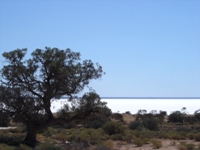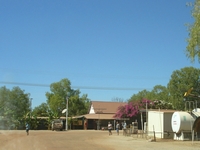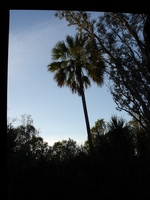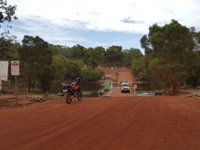Q24 What are the distances between fuel stations on the Stuart Highway between Port Augusta to Darwin?



A. Update: the Cape Leveque Road is now fully sealed.
My best advice is to ask others who have just been there for an up
to date report on the state of the road when you get to Broome, if you plan to stay in Broome. Are you equipped to take a tent
and camp all the way to and including at Kooljaman? You can only take a caravan as far as Middle Lagoon, but whether you
would get in to Kooljaman with your Eagle under the camper trailer banner I do not know. You need to make booking for
Middle Lagoon and most stay several days to enjoy to beauty and do day trips to places such as Beagle Bay, Cape Leveque, Lombadina and
One Arm Point (Ardyaloon). The worst part of the road is getting that far, and the road is known for 150 sandy kilometres of
bone rattling corrugations, with a thirty kilometre rough track to get into the campground as well. Much of the road further
north is sealed but tracks still need to be traversed to get to most localities.
If you do decide to take your Eagle,
lower tyre pressures and travel slowly. The biggest risk in these distant areas is cost of recovery if the camper needs recovery
should it suffer something like suspension damage. I don’t know if you have travelled many corrugated roads, but every corrugation
is doing your rig damage (and your car as well). Even if it doesn’t show at the time; the damage is cumulative. Check
everything that can come unscrewed inside and outside on the camper. Things at risk internally may be cupboard attachments and
cupboard doors, fridge tray supports and internal freezer if a small single door fridge.
You may like
to consider alternatives to taking your own vehicle and/or camper. We have friends with a real off road caravan who choose the
adventure tracks that few dare to travel even without a caravan. Rather than risk damaging their rig, they chose to take
a two day adventure tour of the Dampier Peninsula, so this is another option.
Others have chosen to protect their rig and hired a Landcruiser camper from Broome to go the whole way and get into the different places such as Bully’s Camp (Djoodoon), Quandong Beach and Chile Beach (vans are permitted at Chile). Whalesong Café (Munget) is another lesser known site with campground.Additionally Banana Well Getaway is anther camping and cabin accommodation option.
Another thing to remember in these campgrounds is that no matter how inviting the water looks, there is a chance of crocodiles and other much smaller nasties in the water. As much as I love a swim, I choose not to take the risk.
2014 and updated January 2021
A. Aboriginal lands permit:
Most Aboriginal lands in Queensland do
not require permits to transit.
Camping: Due
to pressure of the QParks campgrounds, a book system now applies, although this is difficult to manage as no-one knows their
timeframes. Other locally run campgrounds may require payment for a “camping permit” but this is no different to campgrounds
anywhere else, and is paid at the location.
For those wanting commercial caravan park options see Cape York Peninsula
Camping. In addition to this list there is Merluna Station, who have just a few powered sites available in addition to a
roomy unpowered camping area.
Alcohol: Be aware you cannot carry any alcoholic drinks when transiting some of the
communities, and strict limits apply in others. See Alcohol Restrictions for Travellers for what and where.
Click on Injinoo for the specific requirements of the Peninsula.
The biggest risk is from travellers coming the other way on short time frames, travelling too fast and without due care and attention. Rollovers and collisions are not uncommon in peak tourism season.
2014 and updated December 2014
Main Roads rest areas for South Australia can be obtained from an RAA App. A map showing rest areas can be viewed from Location SA Map Viewer, but this gives no details of size or suitablitlity of the rest areas. Not all will be suitable for overnight stays and those that are may fill early in the afternoon.
Main Roads rest areas are shown here for the Stuart Highway within the Northern Territory
Port Augusta to Pimba (intersection with turnoff to Woomera) 173 kilometres(LPG)
From Pimba, Woomera is only eight kilometres to the north and a worthwhile detour to see
outdoor and indoor displays of the history of the Woomera Rocket Range. Caravan park at Woomera.
At the road junction, Spud's Roadhouse is a popular overnight stopping place, with all roadhouse services, as well as unpowered sites available for a gold coin donation. Coins showers (2 x $1 coins) and toilets.
Lake Hart has an unserviced rest area with information boards where some self contained travellers stay overnight.
Pimba to Glendambo 113 kilometres (LPG)
Coober Pedy is the service centre for the largest opal mining area in the world. In such a hot area, many of the homes are “dug-outs”.
32 kilometres to the north you can access The Kanku-Breakaways, colourful eroded hills which are at their best in the early morning light or at sunset. No camping.
Matheson Bore Rest Area, 40 kilometres south of Cadney Park, 112 kilometres north of Coober Pedy, on west side
of highway. Unsealed track goes back around 200 metres to a large area, near the Ghan train line. Roofed picnic area,
pipeline to a water tank (non potable). bins. One of the better options to get away from the highway traffic.
Cadney Homestead to Marla 84 kilometres (LPG)
Agnes Creek
Rest Area, around 100 kilometres north or Marla at Agnes Creek bed. Signed as a picnic area from the highway, where an unsealed
track goes about 100 metres from the highway, east side, to a cleared area. No services. An alternative track goes further from
the highway. This is one of many rest areas, but better being set back from the highway.
Near the South Australian – Northern Territory border, 295 kilometres south
of Alice Springs, the border 24 hour roadside rest area is also popular for overnight. which has toilet, picnic shelters,
barbecues and a small tank for water.
Desert Oaks 24 hour roadside rest area is large enough to get away from the highway and has toilet, picnic shelters, barbecues and a small tank for water. One of the better Stuart Highway rest areas.
There is a popular but small 24 hour roadside rest area by the Finke
River Bridge 74 kilometres north of Erldunda which toilet, picnic shelters, barbecues and a small tank for water.
Stuarts Well Roadhouse offers all levels of accommodation, including free for
self contained campers.
Rainbow Valley turnoff is 14 kilometres north of the roadhouse with 23 kilometres of unsealed road to reach Rainbow Valley. There is a National Parks camping area suitable for small rigs.
Alice Springs is a very
well provisioned large town, with plenty to see and do. See our travelogues of Alice Springs and surrounds
Attack Creek is a good 24 hour rest area with toilets 47 kilometres north of Three Ways.
Although close to the Highway it is popular for overnight stays.
Daly Waters Airfield was the first international airfield in Australia and the Daly Waters Pub boasts the longest held hotel licence in the Northern Territory. (Daly Waters is five kilometres from the Stuart Highway)
The Daly Waters access road is approximately three kilometres north of the Carpentaria Highway turn-off, where the Hi-Way Inn Roadhouse offers a full range of services including fuel, Autogas (LPG), caravan park, cabin and motel accommodation, a licensed restaurant and bar, plus takeaway food.
36 kilometres south of Mataranka, Warlock roadside rest area has toilets, picnic shelter, barbecues
and tank water. This is one of the better rest areas for overnight but it fill by then end of the afternoon.
47 kilometres south of Katherine, King River rest area
has toilets, picnic shelter, barbecues and tank water. This is one of the better rest areas for overnight
